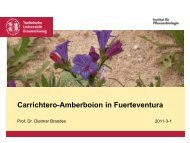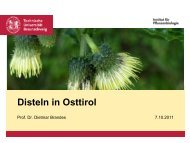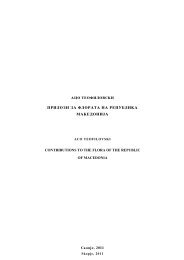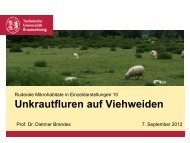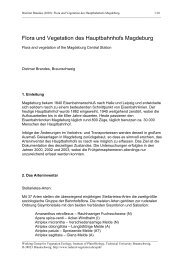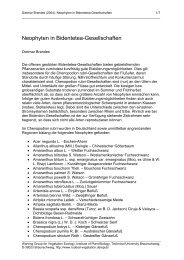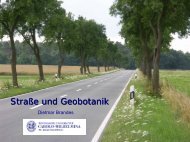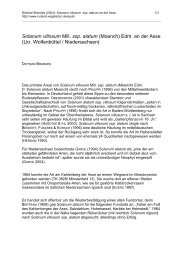Synanthropic flora of Petra (Jordan)
Synanthropic flora of Petra (Jordan)
Synanthropic flora of Petra (Jordan)
You also want an ePaper? Increase the reach of your titles
YUMPU automatically turns print PDFs into web optimized ePapers that Google loves.
<strong>Synanthropic</strong> <strong>flora</strong><br />
<strong>of</strong> the archaeological sites <strong>of</strong><br />
<strong>Petra</strong> (<strong>Jordan</strong>)<br />
Pr<strong>of</strong>. Dr. Dietmar Brandes<br />
http://www.ruderal-vegetation.de/verschiedene_regionen/index.htm
<strong>Petra</strong> – Ancient capital <strong>of</strong> the Nabateans<br />
Khazne al-Firaun „Treasury“<br />
• The most famous place <strong>of</strong> <strong>Jordan</strong> is<br />
<strong>Petra</strong>, the former capital <strong>of</strong> the<br />
Nabateans. The hidden location, the<br />
safe water supply and the position at the<br />
crossing <strong>of</strong> the Incense Route and the<br />
overland route from Egypt to India gave<br />
the Nabateans a hold over the trade.<br />
• Some 800 monuments are still to be<br />
found in the area. In 1985 <strong>Petra</strong> was<br />
designated a World Heritage Site; in<br />
2007 it was named one <strong>of</strong> the New<br />
Seven Wonders <strong>of</strong> the World.<br />
• <strong>Petra</strong> (30 19‘ 44‘‘N 35 26‘ 25‘‘O) is<br />
situated in an altitude between 800 and<br />
1.350 m.<br />
• From the biogeographical point <strong>of</strong> view<br />
it is near the crossing <strong>of</strong> the<br />
Mediterranean region, the Irano-<br />
Turanion region, the Saharo-Arabian<br />
and the Sudanian region.
• The access to the<br />
ancient city <strong>of</strong> <strong>Petra</strong><br />
leads through the very<br />
impressive Siq, a dim<br />
gorge in the Umm Ishrin<br />
sandstone.<br />
• The Siq has a length <strong>of</strong><br />
1.200 m, the walls are<br />
90-180 m high.
<strong>Synanthropic</strong> <strong>flora</strong> <strong>of</strong> the Siq<br />
Adiantum capillus-veneris, Anchusa strigosa, Ajuga chia, Arum<br />
elongatum, Ballota cf. Undulata, Bryonia, Capparis spinosa, Carduus<br />
cf. argentatus, Daphne linearifolia, Diplotaxis harra,<br />
Echinops, Emex spinosa, Ephedra, Ferula communis, Ficus carica,<br />
Galium aparine, Gomphocarpus sinaicus, Hyoscyamus aureus,<br />
Juniperus phoenicea, Lamarckia aurea, Leopoldia comosa, Malva<br />
parvi<strong>flora</strong>, Malva sylvestris, Marrubium vulgare, Matthiola longipetala,<br />
Nerium oleander, Parietaria alsinifolia, Parietaria judaica, Phlomis,<br />
Phragmites australis, Podonosma orientalis, Salvia lanigera,<br />
Sanguisorba cf. minor, Scrophularia nabataeorum, Senecio glaucus<br />
subsp. coronopifolius, Sisymbrium irio, Sisymbrium orientale, Umbilicus<br />
intermedius, Urtica pilulifera.
↑ Capparis cf. spinosa (Capparidaceae)<br />
↖ Galium canum (Rubiaceae)
Podonosma orientalis<br />
(Boraginaceae)
Parietaria alsinifolia enlarged ↗
Scrophularia nabataeorum (Scrophulariaceae)
Overgrazed and degraded steppe and semi-desert with Urginea maritima
Overgrazing by goats results in degradation <strong>of</strong> the vegetation
Juniperus phoenicea, Thymelaea hirsuta and Urginea maritima
Thymelaea hirsuta (Thymelaeaceae)
Ononis natrix (Fabaceae)
Urginea maritima und Ononis natrix
Peganum harmala and Urginea maritima
Tab. 1: Urginea maritima - Peganum harmala - community<br />
Number <strong>of</strong> relevé 1 2 3 4 5 6 7 8<br />
area [m²] 30 20 30 20 10 30 30 50<br />
vegetation cover [%] 20 20 25 15 30 20 15 35<br />
number <strong>of</strong> species 11 7 8 11 8 9 10 10<br />
Urginea maritima 3.2 3.2 2.2 2.2 2.1 2.2 2.2 2.2<br />
Peganum harmala 2.2 2.2 2.2 2.2 1.1 2.2 + 3.3<br />
Ononis natrix 1.1 1.1 1.1 1.1 + + 1.1 .<br />
Malva parvi<strong>flora</strong> + . 1.1 1°.1 1.2 1.2 . 1.1<br />
Thymelaea hirsuta 2.2 2.1 . . . 2.2 1.1 1.1<br />
Hyoscyamus aureus r + + 2.1 . . . .<br />
Cynodon dactylon +.2 . + . 1.2 . . 1.2<br />
Marrubium vulgare . + 1.1 + 1.1 . . .<br />
Emex spinosa +° . . . + . . +°<br />
Astragalus cf. tribuloides + . . . . . + .<br />
Ifloga spicata + . . . . . . +.2<br />
Plantago cf. albicans . . . . . 1.2 1.2 .<br />
Retama raetam . . . . . + +° .<br />
further species 1 1 1 5 1 2 3 3
Peganum harmala (Zygophyllaceae)
Marrubium vulgare<br />
(Lamiaceae)
Launaea capitata (Asteraceae)
Matthiola longipetala (Brassicaceae)
Trigonella stellata (Fabaceae)
Daphne linearifolia<br />
(Thymelaeaceae)<br />
Ferula communis<br />
(Apiaceae)
Reichardia tingitana (Asteraceae)
Anchusa aegyptiaca (Boraginaceae)
Farsetia aegyptiaca (Brassicaceae)
Forsskaolea tenacissima (Urticaceae)
Aloe vera (Liliaceae). An alien plant - possibly introduced by the Nabataeans for<br />
medicinal purposes (Ruben & Disi 2006).
Aloe vera (Liliaceae)
Salvia lanigera (Lamiaceae)
Roemeria hybrida<br />
(Papaveraceae)
Astragalus spinosus (Fabaceae)
Gastrocotyle hispida (Boraginaceae)
Psoralea flaccida (Fabaceae)
Caylusea hexagyna (Resedaceae)
Erodium hirtum (Geraniaceae)
Fagonia mollis (Zygophyllaceae)
Ajuga chia (Lamiaceae)
Leopoldia comosa (Hyacinthaceae)
Juniperus phoenicea (Juniperaceae)
Plants <strong>of</strong> wadis<br />
Nerium oleander<br />
Gomphocarpus sinaicus<br />
Daphne linearifolia<br />
Fritillaria libanotica<br />
Arum elongatum<br />
Brunnera orientalis<br />
Parietaria judaica<br />
Ochradenus baccatus<br />
Diplotaxis harra<br />
Aloe vera (relic <strong>of</strong> cultivation?)<br />
Small wadi
Gomphocarpus sinaicus (Asclepiadaceae)
Diplotaxis harra (Brassicaceae)
Ochradenus baccatus (Resedaceae)
Brunnera orientalis (Boraginaceae)
Arum cf. elongatum (Araceae)
Fritillaria libanotica (Liliaceae)<br />
Asphodeline lutea (Liliaceae)
Pistacia atlantica (Anacardiaceae) and Nerium oleander (Apocynaceae)
Olea europaea cultivated in the vicinity <strong>of</strong> the modern village
Ruderal vegetation with some Chenopodiaceae
References<br />
• Al-Eisawi, D. M. H. (1996): Vegetation <strong>of</strong> <strong>Jordan</strong>. – Cairo. VII, 284 S.<br />
• Al-Eisawi, D. M. H. (1998): Field guide to wild flowers <strong>of</strong> <strong>Jordan</strong> and neighbouring<br />
countries. Amman. 296 p.<br />
• Old Dominion University (2007): Checklist <strong>of</strong> plants <strong>of</strong> the Hashemite Kingdom <strong>of</strong><br />
<strong>Jordan</strong>. Compiled originally by Al-Eisawi, D. M. H. & A. Khader (1998).<br />
http://www.odu.edu/~lmusselm/plant/jordan/index.php (vidi 2010-3-29)<br />
• Ruben, I. & A. Dasi (2006): Field guide to the plants and animals <strong>of</strong> <strong>Petra</strong>. –<br />
Amman. 224 p.<br />
Address <strong>of</strong> the author:<br />
Pr<strong>of</strong>. Dr. Dietmar Brandes<br />
Arbeitsgruppe für Vegetationsökologie<br />
Institut für Pflanzenbiologie der TU Braunschweig<br />
d.brandes@tu-bs.de




